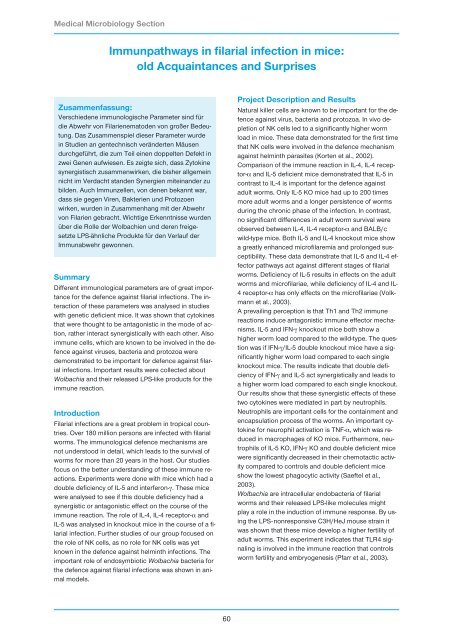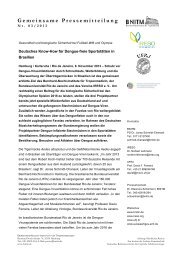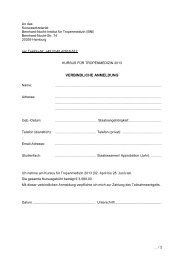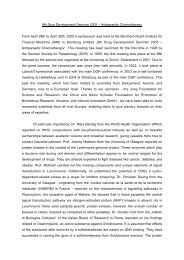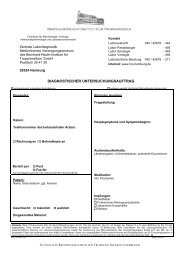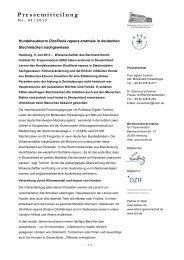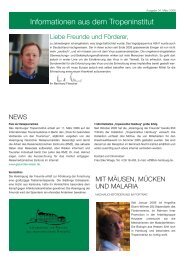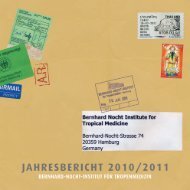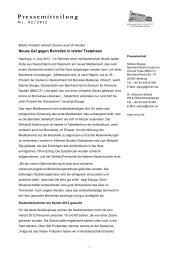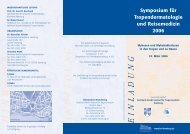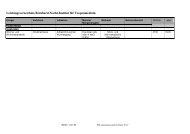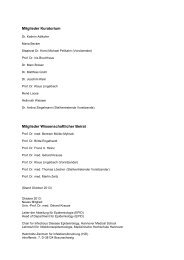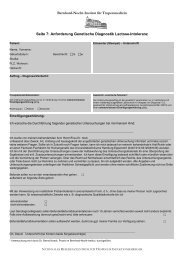Research Group Heussler (Malaria I) - Bernhard-Nocht-Institut für ...
Research Group Heussler (Malaria I) - Bernhard-Nocht-Institut für ...
Research Group Heussler (Malaria I) - Bernhard-Nocht-Institut für ...
Create successful ePaper yourself
Turn your PDF publications into a flip-book with our unique Google optimized e-Paper software.
Medical Microbiology Section<br />
Immunpathways in filarial infection in mice:<br />
old Acquaintances and Surprises<br />
Zusammenfassung:<br />
Verschiedene immunologische Parameter sind <strong>für</strong><br />
die Abwehr von Filarienematoden von großer Bedeutung.<br />
Das Zusammenspiel dieser Parameter wurde<br />
in Studien an gentechnisch veränderten Mäusen<br />
durchgeführt, die zum Teil einen doppelten Defekt in<br />
zwei Genen aufwiesen. Es zeigte sich, dass Zytokine<br />
synergistisch zusammenwirken, die bisher allgemein<br />
nicht im Verdacht standen Synergien miteinander zu<br />
bilden. Auch Immunzellen, von denen bekannt war,<br />
dass sie gegen Viren, Bakterien und Protozoen<br />
wirken, wurden in Zusammenhang mit der Abwehr<br />
von Filarien gebracht. Wichtige Erkenntnisse wurden<br />
über die Rolle der Wolbachien und deren freigesetzte<br />
LPS-ähnliche Produkte <strong>für</strong> den Verlauf der<br />
Immunabwehr gewonnen.<br />
Summary<br />
Different immunological parameters are of great importance<br />
for the defence against filarial infections. The interaction<br />
of these parameters was analysed in studies<br />
with genetic deficient mice. It was shown that cytokines<br />
that were thought to be antagonistic in the mode of action,<br />
rather interact synergistically with each other. Also<br />
immune cells, which are known to be involved in the defence<br />
against viruses, bacteria and protozoa were<br />
demonstrated to be important for defence against filarial<br />
infections. Important results were collected about<br />
Wolbachia and their released LPS-like products for the<br />
immune reaction.<br />
Introduction<br />
Filarial infections are a great problem in tropical countries.<br />
Over 180 million persons are infected with filarial<br />
worms. The immunological defence mechanisms are<br />
not understood in detail, which leads to the survival of<br />
worms for more than 20 years in the host. Our studies<br />
focus on the better understanding of these immune reactions.<br />
Experiments were done with mice which had a<br />
double deficiency of IL-5 and interferon-γ. These mice<br />
were analysed to see if this double deficiency had a<br />
synergistic or antagonistic effect on the course of the<br />
immune reaction. The role of IL-4, IL-4 receptor-α and<br />
IL-5 was analysed in knockout mice in the course of a filarial<br />
infection. Further studies of our group focused on<br />
the role of NK cells, as no role for NK cells was yet<br />
known in the defence against helminth infections. The<br />
important role of endosymbiotic Wolbachia bacteria for<br />
the defence against filarial infections was shown in animal<br />
models.<br />
60<br />
Project Description and Results<br />
Natural killer cells are known to be important for the defence<br />
against virus, bacteria and protozoa. In vivo depletion<br />
of NK cells led to a significantly higher worm<br />
load in mice. These data demonstrated for the first time<br />
that NK cells were involved in the defence mechanism<br />
against helminth parasites (Korten et al., 2002).<br />
Comparison of the immune reaction in IL-4, IL-4 receptor-α<br />
and IL-5 deficient mice demonstrated that IL-5 in<br />
contrast to IL-4 is important for the defence against<br />
adult worms. Only IL-5 KO mice had up to 200 times<br />
more adult worms and a longer persistence of worms<br />
during the chronic phase of the infection. In contrast,<br />
no significant differences in adult worm survival were<br />
observed between IL-4, IL-4 receptor-α and BALB/c<br />
wild-type mice. Both IL-5 and IL-4 knockout mice show<br />
a greatly enhanced microfilaremia and prolonged susceptibility.<br />
These data demonstrate that IL-5 and IL-4 effector<br />
pathways act against different stages of filarial<br />
worms. Deficiency of IL-5 results in effects on the adult<br />
worms and microfilariae, while deficiency of IL-4 and IL-<br />
4 receptor-α has only effects on the microfilariae (Volkmann<br />
et al., 2003).<br />
A prevailing perception is that Th1 and Th2 immune<br />
reactions induce antagonistic immune effector mechanisms.<br />
IL-5 and IFN-γ knockout mice both show a<br />
higher worm load compared to the wild-type. The question<br />
was if IFN-γ/IL-5 double knockout mice have a significantly<br />
higher worm load compared to each single<br />
knockout mice. The results indicate that double deficiency<br />
of IFN-γ and IL-5 act synergistically and leads to<br />
a higher worm load compared to each single knockout.<br />
Our results show that these synergistic effects of these<br />
two cytokines were mediated in part by neutrophils.<br />
Neutrophils are important cells for the containment and<br />
encapsulation process of the worms. An important cytokine<br />
for neurophil activation is TNF-α, which was reduced<br />
in macrophages of KO mice. Furthermore, neutrophils<br />
of IL-5 KO, IFN-γ KO and double deficient mice<br />
were significantly decreased in their chemotactic activity<br />
compared to controls and double deficient mice<br />
show the lowest phagocytic activity (Saeftel et al.,<br />
2003).<br />
Wolbachia are intracellular endobacteria of filarial<br />
worms and their released LPS-like molecules might<br />
play a role in the induction of immune response. By using<br />
the LPS-nonresponsive C3H/HeJ mouse strain it<br />
was shown that these mice develop a higher fertility of<br />
adult worms. This experiment indicates that TLR4 signaling<br />
is involved in the immune reaction that controls<br />
worm fertility and embryogenesis (Pfarr et al., 2003).


